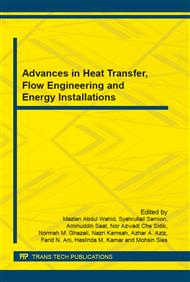p.265
p.272
p.277
p.282
p.287
p.295
p.300
p.305
p.309
Experimental Study on Influence of Surfactant Dosage on Micro Explosion Occurrence in Water in Diesel Emulsion
Abstract:
An experimental investigation has been carried out to study the effect of surfactant dosage on micro explosion phenomenon. Three water in diesel emulsion with 20% water by volume was prepared using mechanical stirring at 17000rpm for 100s.The emulsions were stabilised by a were stabilized by a single surfactant with three different doses. Water in diesel emulsion droplet was suspended on a thermocouple and the evolution of micro explosion was recorded with a high speed camera synchronized with temperature data logger. Secondary atomization of emulsion droplet was observed under Leiden frost regime using a hot plate as the heat source. The results show that the occurrences of micro explosion are affected by the volume of added surfactant by influencing the exploding temperature and waiting time. Physical properties like density, viscosity and surface tension were also found to be influenced by the amount of surfactant used.
Info:
Periodical:
Pages:
287-291
Citation:
Online since:
January 2016
Price:
Сopyright:
© 2016 Trans Tech Publications Ltd. All Rights Reserved
Share:
Citation:


